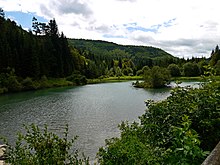Harras (Wehingen)
Harras is a district of the municipality of Wehingen in Baden-Württemberg and is located on the Great Heuberg at 754 m above sea level. NHN .
location
Harras is located in the valley of the Lower Bära , in the Upper Danube Nature Park . Above the village is Wehingen Castle , in the direction of Obernheim , which is about six kilometers away is the artificially created Harrassee . The municipality of Reichenbach am Heuberg is located southeast of Harras .
history
Harras was under the rule of the Lords of Wehingen until it was sold to Upper Austria in 1351 .
In 1697 Emperor Leopold had an iron smelter built in Harras. The iron and steel works consisted of a blast furnace that delivered the iron ingots to the Bärenthal factory. On the Swabian Alb in the open pit to winning Bohnerz with high iron content and the steep drop in the Alb in tunneling delivered to winning Stufenerze the starting raw material. The ore was mined in open pit ore pits, which were larger in size. In Oberheim new climbing created after Harras for the transport of ore from the mining areas at Hausen am Tann ( 48 ° 10 '51.31 " N , 8 ° 50' 49.31" O ) To 1845 degraded by Joseph Schiller Harras iron ore. The independent miners mined at their own risk and were paid by Erzmesser Monitgel in Ludwigsthal according to the amount delivered. Smugglers were also employed in the area of steel production. Touristic tours on smuggling are offered by newly trained Danube guides. Women also did this job: "Between the Black Forest, Alb and Lake Constance, she is on the road as a peddler, blackmailer and worse. Through her father's ore smuggling." In 1698 just under a ton of steel ingots was smuggled on the Reichsstrasse near Kolbingen . There are reports of roe-shaped thone iron stones , of which there was a seam 1 - 2 shoe thick near Gosheim and Wehingen . The operation of the blast furnace was stopped in 1832 due to insufficient utilization and the blast furnace itself was canceled in 1839. Of the factory buildings, only the former officials' house was preserved and served as a district forester's apartment.
In 1805, Harras and the entire county of Hohenberg came to Württemberg through Napoléon .
traffic
With the construction of the Heubergbahn Spaichingen – Reichenbach, which was shut down and dismantled in 1966 , Harras got a train station. The name of the station was Harras-Obernheim because it was also intended for the municipality of Obernheim, which until 1938 belonged to the Spaichingen District Office . Today, Harras can be reached by public transport using the Südbadenbus line 43 ( Aldingen - Königsheim ) and line 61 (Wehingen - Nusplingen ). Harras is on the state road 433 Trossingen - Ebingen and the district road 5906 to Obernheim in the Zollernalb district .
regional customs
Harras has been represented with its own figure within the traditional Wehinger Fasnet since 1974. According to legend, the so-called Harrasweible is said to have played a joke in the Harrasbach valley between Harras and Obernheim. The carters are said to have lost control of their horses due to their ghost. Only after knocking out the thirteenth spoke of the wheels could the troubled wagoners put an end to the hustle and bustle. The horses pulled up again and brought the carts up the steep path to Obernheim.
The larva of the Harrasweible shows an ambivalent face with a laughing and a grouchy side. The hat consists of a skirt , apron , blouse and headscarf . The Harrasweible carries a tuft of beech twigs on her head .
Todays situation
Today Harras has 150 inhabitants. One of the four road maintenance departments of the Tuttlingen district is located in the village .
Individual evidence
- ↑ Holdings E 244 Bü 100 on Landesarchiv-BW.de
- ^ Inventory E 244 Bü 101 on Landesarchiv-BW.de
- ↑ Danube Guides Smuggler
- ↑ The cross-border commuter
- ^ Walter Stettner: Ebingen - The history of a city in Württemberg . Ed .: Jan Thorbecke Sigmaringen. 1986, p. 95 .
- ↑ Friedrich von Alberti: The mountains of the Kingdom of Württemberg, with special reference to halurgy . JG Cotta'sche Buchhandlung 1826, Stuttgart and Tübingen, p. 124 .
- ↑ Description of the Oberamt Spaichingen / Chapter B 20 , on wikisource.org
Coordinates: 48 ° 8 ′ 35 ″ N , 8 ° 49 ′ 25 ″ E
